Theta Delphini
Theta Delphini (θ Del, θ Delphini) is a star in the constellation Delphinus. It has an apparent magnitude of about 5.7, meaning that it is just barely visible to the naked eye under excellent viewing conditions. This star is around 2,050 light years away from the Sun.[1]
 | |
| Observation data Epoch J2000 Equinox J2000 | |
|---|---|
| Constellation | Delphinus |
| Right ascension | 20h 38m 54.454298253s[1] |
| Declination | +13° 18′ 54.454298253″[1] |
| Apparent magnitude (V) | 5.71[2] |
| Characteristics | |
| Spectral type | K3Ib[3] |
| U−B color index | +1.71[4] |
| B−V color index | +1.52[4] |
| Astrometry | |
| Radial velocity (Rv) | -15.09[5] km/s |
| Proper motion (μ) | RA: 3.068[1] mas/yr Dec.: -0.179[1] mas/yr |
| Parallax (π) | 1.5887 ± 0.0738[1] mas |
| Distance | 2,050 ± 100 ly (630 ± 30 pc) |
| Details | |
| Mass | 5.69[6] M☉ |
| Radius | 125[7] R☉ |
| Luminosity | 2,333+1,103 −748[7] L☉ |
| Surface gravity (log g) | 1.3[8] cgs |
| Temperature | 3,986±170[7] K |
| Metallicity [Fe/H] | +0.22[8] dex |
| Rotational velocity (v sin i) | 3.0[9] km/s |
| Other designations | |
| Database references | |
| SIMBAD | data |
Theta Delphini's spectral type is K3Ib, meaning it is a K-type supergiant.[11] These types of stars form when relatively massive (10 to 30 M☉) stars like B-type main sequence stars run out of hydrogen to fuse and start cooling down.[12] It has been described as a super-metal-rich star because of its high metallicity[8]
References
- Brown, A. G. A.; et al. (Gaia collaboration) (August 2018). "Gaia Data Release 2: Summary of the contents and survey properties". Astronomy & Astrophysics. 616. A1. arXiv:1804.09365. Bibcode:2018A&A...616A...1G. doi:10.1051/0004-6361/201833051. Gaia DR2 record for this source at VizieR.
- Ducati, J. R. (2002). "VizieR Online Data Catalog: Catalogue of Stellar Photometry in Johnson's 11-color system". VizieR On-line Data Catalog. Bibcode:2002yCat.2237....0D.
- Bidelman, William P. (1951). "Spectral Classification of Stars Listed in Miss Payne's Catalogue of C Stars". The Astrophysical Journal. 113: 304. Bibcode:1951ApJ...113..304B. doi:10.1086/145399.
- Fernie, J. D. (1983). "New UBVRI photometry for 900 supergiants". Astrophysical Journal Supplement Series. 52: 7–22. Bibcode:1983ApJS...52....7F. doi:10.1086/190856.
- Famaey, B.; Jorissen, A.; Luri, X.; Mayor, M.; Udry, S.; Dejonghe, H.; Turon, C. (2005). "Local kinematics of K and M giants from CORAVEL/Hipparcos/Tycho-2 data. Revisiting the concept of superclusters". Astronomy and Astrophysics. 430: 165–186. Bibcode:2005A&A...430..165F. doi:10.1051/0004-6361:20041272.
- Hohle, M. M.; Neuhäuser, R.; Schutz, B. F. (2010). "Masses and luminosities of O- and B-type stars and red supergiants". Astronomische Nachrichten. 331 (4): 349. arXiv:1003.2335. Bibcode:2010AN....331..349H. doi:10.1002/asna.200911355.
- Messineo, M.; Brown, A. G. A. (2019). "A Catalog of Known Galactic K-M Stars of Class I Candidate Red Supergiants in Gaia DR2". The Astronomical Journal. 158: 20. arXiv:1905.03744. Bibcode:2019AJ....158...20M. doi:10.3847/1538-3881/ab1cbd.
- Malagnini, M. L.; Morossi, C.; Buzzoni, A.; Chavez, M. (2000). "Observations and Atmospheric Parameters of Super-Metal-rich Candidates". Publications of the Astronomical Society of the Pacific. 112 (777): 1455. Bibcode:2000PASP..112.1455M. doi:10.1086/317714.
- De Medeiros, J. R.; Udry, S.; Burki, G.; Mayor, M. (2002). "A catalog of rotational and radial velocities for evolved stars. II. Ib supergiant stars". Astronomy and Astrophysics. 395: 97–98. Bibcode:2002A&A...395...97D. doi:10.1051/0004-6361:20021214.
- "iot Del". SIMBAD. Centre de données astronomiques de Strasbourg. Retrieved 15 January 2016.
- Allen, J. S. "The Classification of Stellar Spectra". UCL Department of Physics and Astronomy: Astrophysics Group. Retrieved 1 January 2014.
- Ekström, S.; Georgy, C.; Eggenberger, P.; Meynet, G.; Mowlavi, N.; Wyttenbach, A.; Granada, A.; Decressin, T.; Hirschi, R.; Frischknecht, U.; Charbonnel, C.; Maeder, A. (2012). "Grids of stellar models with rotation. I. Models from 0.8 to 120 M⊙ at solar metallicity (Z = 0.014)" (PDF). Astronomy & Astrophysics. 537: A146. arXiv:1110.5049. Bibcode:2012A&A...537A.146E. doi:10.1051/0004-6361/201117751.
This article is issued from Wikipedia. The text is licensed under Creative Commons - Attribution - Sharealike. Additional terms may apply for the media files.